
[ad_1]
“], “filter”: { “nextExceptions”: “img, blockquote, div”, “nextContainsExceptions”: “img, blockquote, a.btn, a.o-button”} }”>
Heading out the door? Read this article on the new Outside+ app available now on iOS devices for members!
>”,”name”:”in-content-cta”,”type”:”link”}}”>Download the app.
I spent a lot of years thinking that yoga wasn’t for tall people.
At just under 6′ 6″ tall, I couldn’t even touch my hands to my knees in Standing Forward Bend when I took my first yoga class. Flexibility is something many tall people aren’t accustomed to experiencing in their bodies. I’m pretty certain that my hamstrings are tighter than those of most humans. Also, many tall people tend to suffer from tension, strain, and pain in the lower back and neck because we’re constantly hunching forward and looking down—because of our vantage and, if you’re like me, because you’re self-conscious about taking up more than your share of space in the world.
All of that can make it confusing and time-consuming to find safe alignment in yoga poses, especially when you’re trying to keep up with a vinyasa class. That’s to say nothing of that moment of awkwardness when you walk into an already packed studio and search for space to unroll your extra-long mat or when your wingspan is broader than that of most students around you and you feel like you’re always in the way, even when you’re not.
It wasn’t until I began to practice yoga at home during the forced solitude of the pandemic that I started to understand my mistake. I had tried to run before I could walk. Rather than continuing with online vinyasa classes meant for experienced students, I started at the beginning. I took the time to explore each pose and find adjustments that felt okay in my body. And, in my own space and time, I came to understand that poses look different in every body—and that’s okay.
Now that I teach yoga, I find that a lot of my classes tend to attract those who, like me, fit on the taller end of the spectrum. I can help them adapt the various poses to their bodies, even when they’re not quite certain they want to be in their own bodies on a yoga mat.
The practice of yoga invites us to constantly meet our minds and our bodies where we are, which is uncomfortable and rewarding all the same. The poses can feel particularly challenging at first, especially if you’re tight in your hamstrings, hips, and shoulders. Be patient and be kind to yourself in the words you choose as you explore along your journey. With time, you’ll start to find more space in your spine, opening in your shoulders, and confidence in your body—and not just when you’re practicing yoga.
9 Yoga Poses for Tall People
Whether you’re new to yoga or not, the following approaches to common yoga poses for tall people can help you better address your needs, especially if you’re taller than 6’2″. You simply need to adjust your relationship to your practice, in your body and your mind.
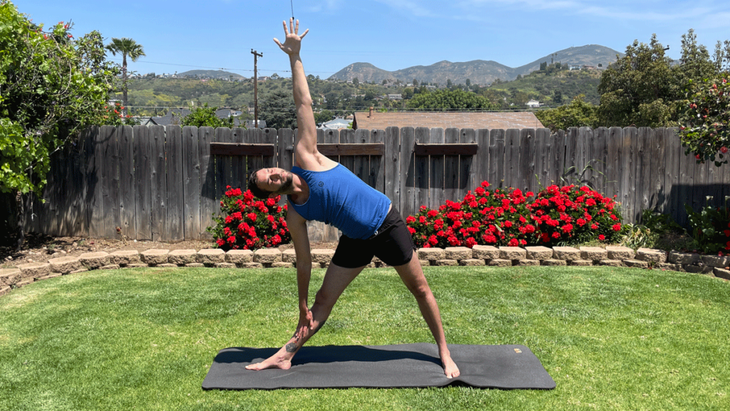
1. Triangle Pose
This pose stretches the hamstrings and the muscles of your inner thighs while stretching your chest and shoulders. Any variation of Triangle can help you counteract constant hunching.
How to: Begin in Warrior 2 with your right foot forward and your left leg back with your chest facing the left long side of the mat and arms in a T position. Inhale as you reach your right arm forward and bump your left hip back, and then exhale as you lean over your right thigh and bring your right hand either to a block, your right thigh or shin, or the mat. Extend your left arm straight above to stack your shoulders or take a bind (see side body stretch below).
To lessen the strain in your lower or front leg: Step your left leg further back to help find some opening in your hips.
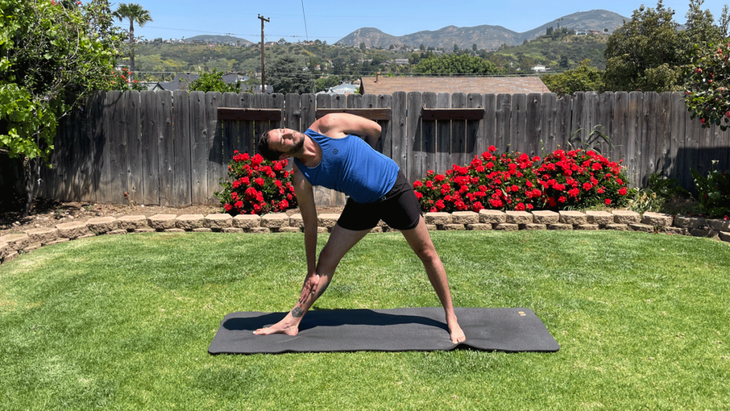
To increase the stretch in your chest, shoulder, and side body: Reach your left arm alongside your ear toward the front of the mat or find a half bind by bending your left elbow and reaching your arm behind your back.
To increase the stretch in your chest and shoulders: Bring your right hand higher up your leg to make that broadening easier.
To increase the stretch along the back of your front leg: Lower your right hand closer to your right foot. But take note if you start to strain and collapse in your shoulders simply to lower your hand.

2. Pyramid Pose
Because the focus of this hamstring stretch is on one leg at a time, your body can open in a slower, more controlled manner. Taking blocks beneath your hands lessens the intensity of the stretch and makes breathing into the pose much easier.
How to: Set your legs up like you’re going into Triangle Pose with your right foot forward but shorten your stance and square your hips toward the front of the mat, as if you’re going into Warrior 1 Pose. Inhale to lift your arms alongside your ears and lengthen your spine, and then exhale as you fold forward over your right thigh into Pyramid Pose. Place your hands on your front leg or on blocks. Maintain a microbend in your right knee to avoid hyperextension. Work to keep your hips in line with each other by actively drawing your right hip toward the wall behind you.
To increase the stretch across your chest and front of your shoulders: Interlace your fingers behind your back and bring your hands toward the ceiling.
To lessen the balancing component of the pose: Feel free to drop your back knee to the mat if you need even more support and practice Half Splits.
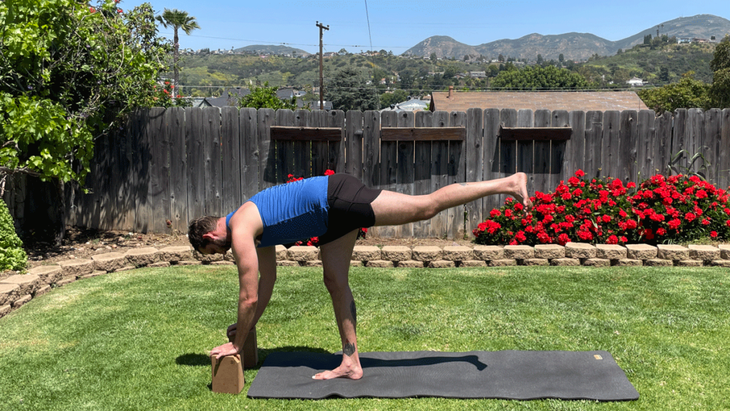
3. Standing Splits
This pose strengthens your balance and your hip abductors, which can help you build strength in your legs and lower back. This is also a good pose to practice before eventually coming into Warrior 3 Pose.
How to: Start in a lunge with your right foot forward, your left leg extended straight behind you, and your hands resting on blocks framing your right foot. Bring your gaze down and in front of your right foot. Move your hands and blocks 8 inches or so in front of your foot as you inhale and lift your left leg as you straighten your right leg.
To intensify the balancing component: Practice coming into your fingertips and lifting one hand at a time to your chest before eventually finding prayer hands.
To intensify the strengthening: You can add some strengthening in your glutes with this pose by exploring Shiva Squats. Exhale as you bend your right knee and bring your left knee behind your right calf, then inhale to straighten your right tleg Having longer legs is an advantage in these squats, so use them to your benefit!
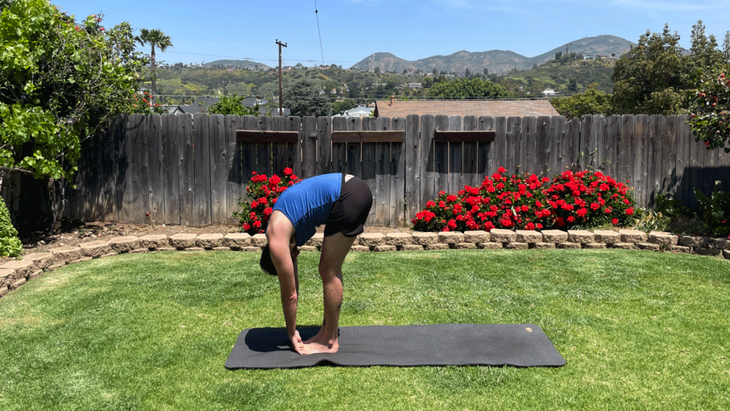
4. Standing Forward Bend With Hands Beneath Feet
Tall people especially can struggle with hamstring strength and flexibility. This intense pose allows you to gradually increase the intensity of the stretch along the back of your legs and your lower back. The ground is much further away when you’re tall, but if you keep practicing, you’ll get there.
How to: Begin in a Standing Forward Bend. Inhale into a halfway lift, and then exhale as you release your chest toward your thighs and bring your hands, palms up, underneath your feet.
To lessen the intensity in your hamstrings: At first, you may have to keep a deep bend in your knees, which will add a burn in your quads and potentially make this pose more difficult to hold.
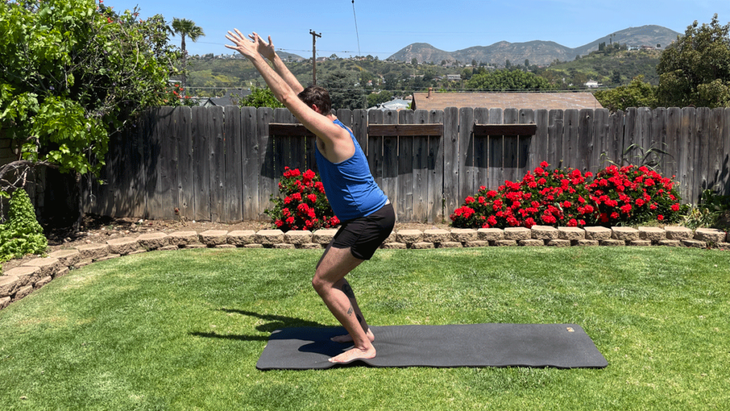
5. Chair Pose
This is a great posture for strengthening your legs, but also one that can help you find opening and expansion in your chest and shoulders.
How to: Begin in a Standing Forward Bend. Inhale into a halfway lift, then exhale back into a Forward Bend. Inhale to find a Chair Pose by bending your knees, taking a squat, and lifting your arms alongside your ears and spiraling your biceps and pinkies toward each other. Keep your weight heavy in the back of your heels, sink into your hips, and squeeze your glutes to help yourself find that activation.
To lessen the intensity in your lower back or knees: Bring your feet hip-distance apart to help support your lower body.
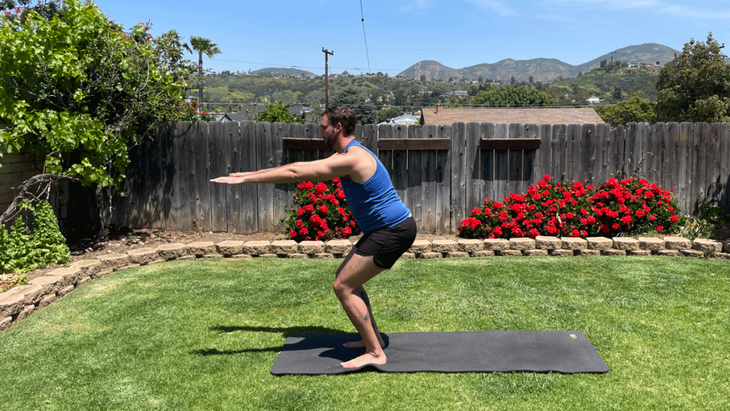
To lessen the intensity in your shoulders: Extend your arms straight in front of you and keep your palms facing down. Or you can bring your hands to prayer at your heart center and let your shoulders rest completely. This can also alleviate any lower back pain you may experience even after widening your stance.
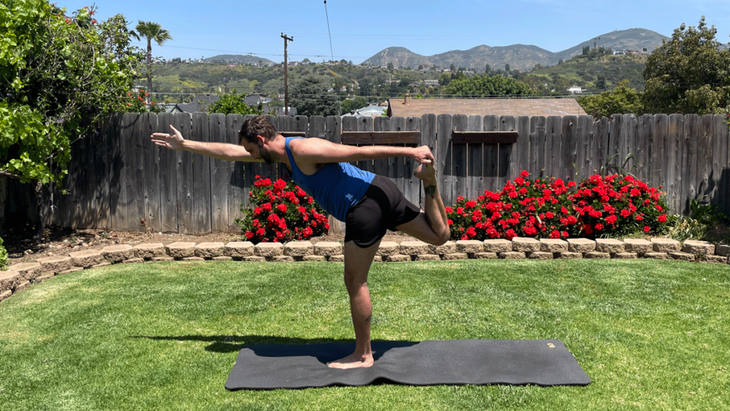
6. Revolved Dancer Pose
This is a great yoga pose for tall people to challenge their balance and stretch your chest and shoulders, while playing around in a balancing twist.
How to: Begin in a Mountain Pose. Inhale to bring your arms alongside your ears and lengthen your spine, then exhale into a Standing Forward Bend. Inhale and bend your right knee and bring your heel toward your sit bone as you start to stand. Exhale as you drop your left hand behind your back and catch hold of your right foot. Take a moment to draw your right knee toward your center to avoid flaring it out to the side. Inhale to stretch your right arm higher, and then exhale into a Revolved Dancer Pose by gently tilting forward to any degree. Find a spot for your drishti (your gaze) to help you bring the focus a little more inward. Inhale as come upright, release your grip, and slowly exhale into your Standing Forward Bend.
To lessen the intensity in your lower back: Maintain a slight contraction in your right glute as you kick your right leg a little higher so you’re kind to your lower back.
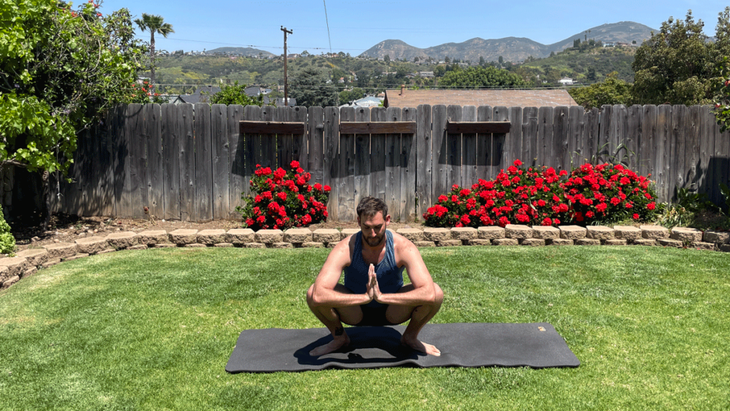
7. Squat
Tight hip muscles usually result in overcompensation by your lower back, which increases your risk of tightness, soreness, and injury. This pose helps open and strengthen your hips as well as stretching out along your heels and inner thighs. It’s also a helpful posture to practice and play around with if you’re working toward Crow Pose.
How to: Begin standing with your legs just a little wider than hip-distance apart. Turn your heels in, toes out, and bend your knees to squat your hips all the way toward the floor.
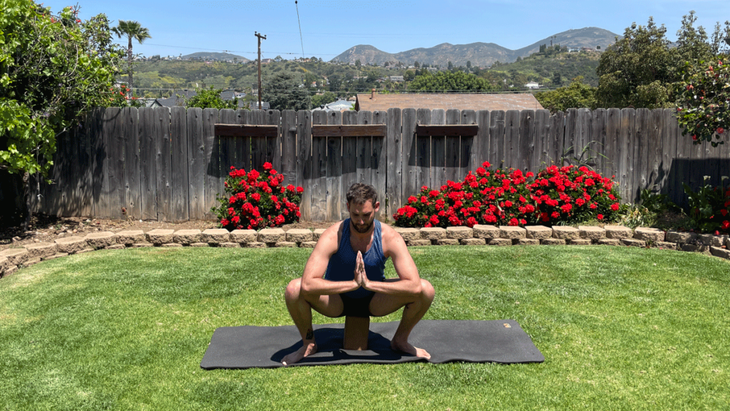
To lessen the intensity in your hips: Place a block or two under your sit bones if you need additional support.
To lessen the intensity in your calves: If you’re newer to this pose, it’s also likely you’ll have a hard time keeping your heels on the ground. You can partially roll your mat or bring a blanket or pillow under your feet if it’s uncomfortable. Otherwise, your body will open up over time and you’ll mentally high-five yourself when you notice far you’ve come.
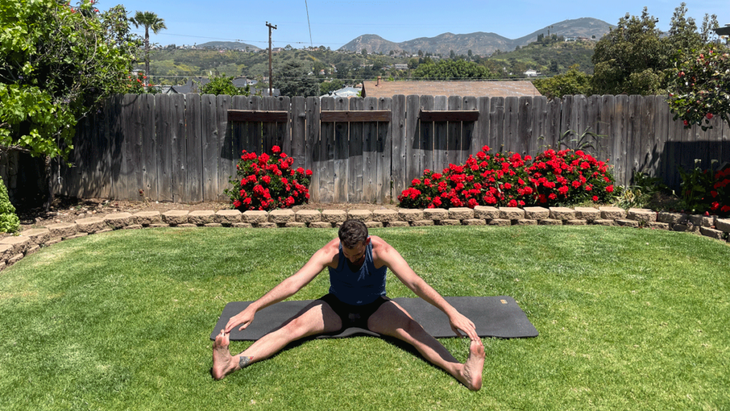
8. Wide-Angled Seated Forward Bend
This was, and probably still is, among the hardest poses for my tall body at the beginning of my practice. I hardly noticed the progress along the way, but I’m still shocked that I can now hold onto my toes. This pose helps open your hips, lower back, inner thighs, and hamstrings.
How to: Begin in a seated position with your legs extended straight in front of you. Widen your legs any amount that is comfortable. Keep your mind focused on your own body and don’t worry about how it might look in anybody else’s; you don’t have to be in side splits here. In time, you can bring your legs wider apart, but for now, take the opportunity to simply meet your body where it is and explore. Inhale to bring your arms overhead to lengthen your spine, then exhale to fold forward into a Wide-Angled Seated Forward Bend. Don’t worry about how far forward you fold. Just meet your body where it’s at in the stretch.
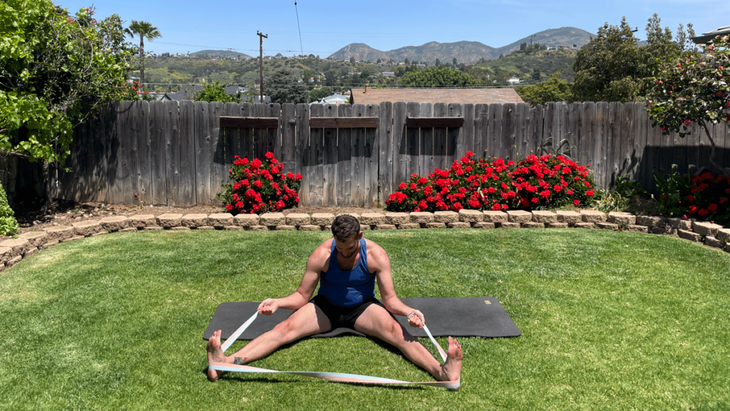
To lessen the intensity in your outer hips: Take your legs closer toward one another. Also, you can sit on a block a folded blanket, bend your knees, or loop a strap or belt around your feet and gently pull your chest closer toward your feet.
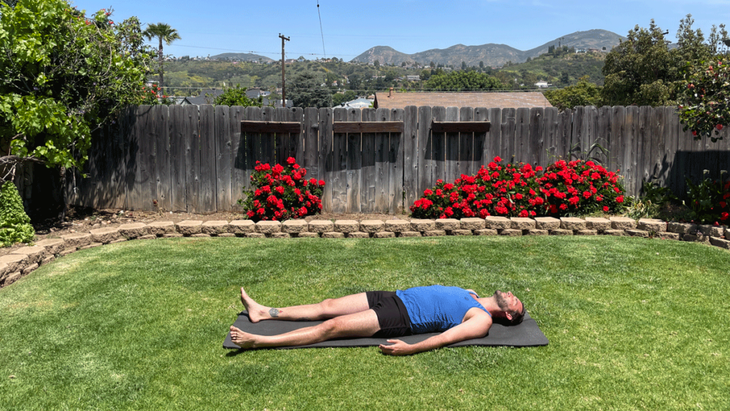
9. Savasana (Corpse Pose)
When you’re ready, release onto your back for Savasana.
How to: Take up as much space as possible here because this is the ultimate pose to sink into your unique body. Corpse Pose represents a time to release something that no longer serves you and reawaken as a new version of you. Allow yourself to relax and let your body absorb all of the opening and strength it’s created throughout this practice.
To lessen the intensity in your lower back: Place a pillow or a folded blanket under your sacrum for support.
You may want to use this final space after as a time to reflect on your place in the world of yoga. It may feel like it’s not designed for you, or that you don’t fit if you can’t be in a certain mold, or that you’re constantly in the way. You’re not. You’re right where you need to be, in the exact body you’re meant to be in, and you deserve this practice just as much as anybody else.
About Our Contributor
[ad_2]